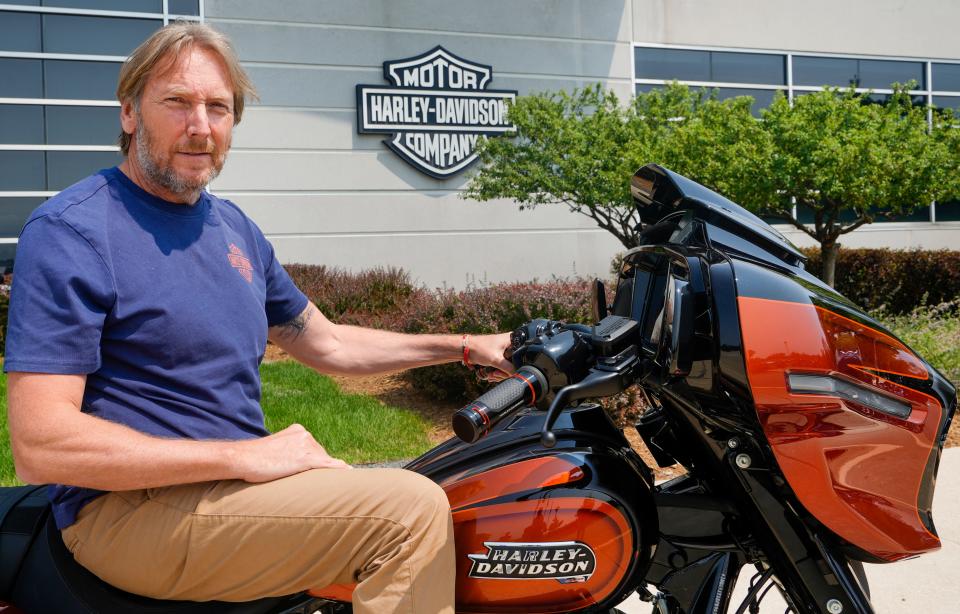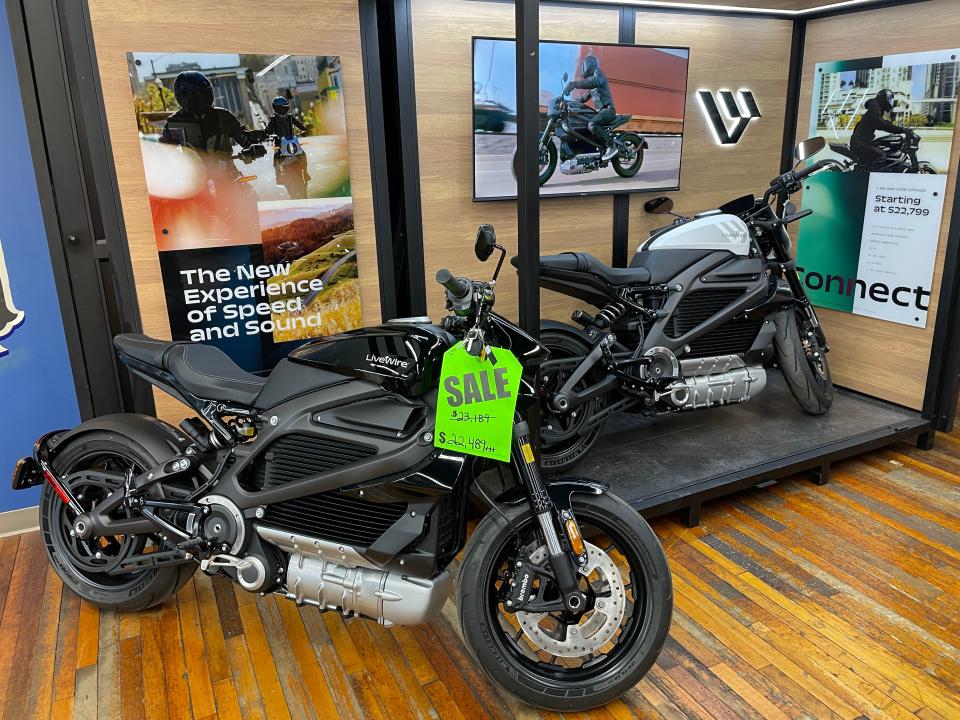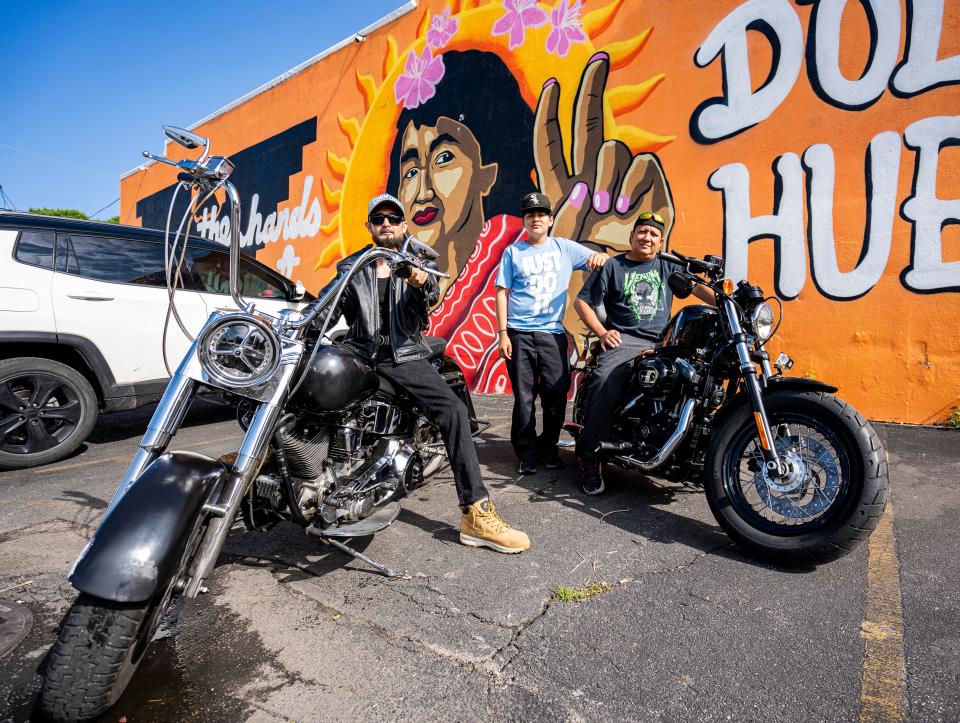How Harley-Davidson's CEO plans on making the company's motorcycles a premium brand
Jochen Zeitz took the helm at Harley-Davidson in an especially difficult time.
It was early 2020 and the company was in trouble. Bike sales had fallen for years, the product lineup lacked focus, and the growth strategy hadn’t produced results.
Then, things got even worse.
A month after Zeitz was named interim chief executive officer, replacing CEO Matt Levatich, Harley suspended production at its U.S. factories after a Wisconsin employee tested positive for the coronavirus.
The company’s global supply chain was broken by the pandemic and material costs soared. Bikes couldn't be built until essential computer chips arrived from Asia. Dealerships closed and sales dried up.
Zeitz was in crisis mode.
“We didn’t know when the factory would be opening again…We had to find a couple of billion dollars to make sure that things could stay afloat,” he said in a Milwaukee Journal Sentinel interview last week.

Doubling down on large cycles
But the company, which celebrates its 120th anniversary this month, had weathered historic hard times such as the Great Depression, World War II, and the 2008 financial crisis.
The new CEO launched a turnaround plan which doubled down on Harley’s core products: touring bikes, large cruisers, and trikes.
He pulled out of weak markets, slashed low-profit bike models, and culled dealerships. He made changes in senior leadership roles and focused on rebuilding the brand.
The changes seemed to have paid off.
In the first quarter of this year, Harley’s revenue was up 20% even as its bike sales fell 12% from a year earlier. The company posted a $304 million profit in the quarter, up 37%.
Wall Street has taken notice.
“We don’t think it’s too early to say that it has been a turnaround success story,” Zacks Investment Research said in a note this spring.
Zeitz brought a new perspective to 'Rewire' Harley
Zeitz brought new perspective to Harley-Davidson where much of the leadership had risen through the ranks. Sometimes that’s needed in storied brands where changes don’t come easily, according to industry analyst Jaime Katz with Morningstar Inc.
Harley and many other companies have fought harder for a share of the consumer dollar that’s been strained by inflation, higher mortgages, student load debt, and changes in discretionary spending.
“There’s less money to go around,” Katz said.
Zeitz was known for being a turnaround expert. In the 1990s he transformed near-bankrupt Puma SE into one of the world’s leading sports brands. He had been a Harley-Davidson board member since 2007, which gave him insight into the company’s operations.
Zeitz's turnaround plan at Harley, named “Rewire", and later “Hardwire,” was aimed at revitalizing the company as a premium brand.
The strategy replaced Levatich’s “More Roads to Harley” plan which had called for the introduction of 100 new high-impact motorcycles over 10 years and a major increase in international business.
Zeitz focused on bikes with solid profit margins, and realized he couldn’t turn back the clock to 2008 when the company produced more than 300,000 bikes that year. Maybe that wasn’t even desirable.
“We don’t want to chase volume for the sake of volume,” he said in the recent interview.
But trouble was never far from his doorstep.
In early 2021, the European Union threatened a 56% tariff on U.S.-made motorcycles and other products including Kentucky bourbon and peanut butter.
It was retaliation for tariffs the United States imposed on EU steel and aluminum.
Europe is Harley’s second largest market, behind North America, and the 56% tariff would have effectively closed it to the company.
The steep tax hike was dropped, but not before it cost Harley millions.
“It certainly wasn’t something I anticipated on top of the pandemic and everything else,” Zeitz said.

What happened to Livewire, Harley's first electric cycle?
In November 2018, a production version of Harley-Davidson’s first electric motorcycle, named LiveWire, was unveiled at an international motorcycle show in Milan, Italy.
Harley had logged thousands of public test rides on electric prototypes, and the feedback it received was favorable. The bike was quiet, quick, and smooth.
But maybe it was too quiet. The electric motor didn’t have the syncopated "potato, potato, potato" rumble that resonated from a Harley V-Twin engine, a sound the company once unsuccessfully sought to trademark.
LiveWire also lacked the operating range and charging access points for motorcyclists accustomed to long-distance rides, such as 870 miles from Milwaukee to the Sturgis Motorcycle Rally in South Dakota's Black Hills.
Harley’s electric bike was expensive, with initial units priced at around $30,000. It faced competition from California-based Zero Motorcycles which had powerful electric street bikes for less money.
Since its launch in 2019, only a few thousand Livewires have been sold.
Last fall, Harley-Davidson spun off the bike into its own company seeded by $100 million from Harley and another $100 million from Taiwan's Kwang Yang Motor Co.
Harley later put more money into the startup and now owns around 90% of the company that's traded on the New York Stock Exchange.
In the first quarter of this year, LiveWire shipped only 63 electric motorcycles compared with 72 a year earlier. The company’s StayCyc brand of kids’ electric balance bikes outsold the motorcycles by a wide margin.
Harley-Davidson had projected more than 100,000 LiveWire motorcycles would be sold in 2026, a goal which at this point seems unreachable.
But it’s too early to discuss numbers and growth strategy, according to Zeitz.
“We think that we have the technology, and that’s the most important thing right now,” he said.
LiveWire could someday revolutionize motorcycling even if it’s not in the touring and cruiser segments where Harley has found success for 120 years. Electric bikes are well suited for urban riding and young riders who grew up in an iPhone culture.
“It’s a question of how we position the brand,” Zeitz said. “I felt that setting it up as a separate entity, with a separate team, was the right approach to really focus on the electrification, while Harley focuses on its core business.”

Has Harley-Davidson lost its connection to riders?
Walter Garron is the kind of customer Harley-Davidson needs.
He’s only 42 and has many years left in motorcycling.
He’s Latino, a demographic Harley has courted to broaden its sales.
He cherishes the rumble of a V-Twin gasoline engine, but he’s also interested in electric bikes.
And he’s loyal to the Harley brand.
“First of all, it’s American made,” Garron said. “I’m in a place that gave me many opportunities as an immigrant. What’s not to love about America?”
Harley-Davidson has been woven into the lifestyle and identity of millions of folks like Garron.
Much of the company’s success has come from its edgy, rebellious image while still appealing to mainstream America.
Yet some question whether Harley has lost that edginess and its connection with riders.
“The guys who used to run the company were bikers themselves,” said Tony Sanfelipo from Milwaukee, who at age 77 has probably logged a million miles in the saddle.
“It’s slowly turning into more of a corporate enterprise,” he said.
Former dealership owner Chaz Hastings says he misses the wild days.
Heavily into R-rated entertainment, his bike shop on Milwaukee’s north side wasn’t typical. There were pole dancers, midget wrestlers, martial arts fighters, Playboy Playmates, the world’s largest beer bong, tattoo artists, bikini bike washes, and of course, motorcycles on the showroom floor.
Now everything’s much too tame at Harley events, according to Hastings, who sold his Milwaukee Harley-Davidson dealership in 2018 and currently owns some bars and Big Boy restaurants.
In his view, Harley’s 120th celebration is more like Summerfest.
“Maybe what we had was lightning in a bottle. I doubt anyone could bring it back,” he said.
Harley-Davidson brings the motorcycle to the party, but it’s the biker community that defines the culture, says Gary Radmer, a longtime Harley rider from Mequon.
Earlier this month he attended the company’s 120th celebration in Budapest, Hungary, where he connected with riders from the Netherlands. Some of the folks he rode with in Budapest are in Milwaukee this week.
“It’s one big family,” Radmer said.
More: Five motorcycles that helped cement Harley-Davidson's image and riders' passion
The company's CEO Zeitz is a rider, too
Zeitz grew up in Germany and went to school in Germany, Italy, France, and the United States. He's a graduate of the European Business School in International Marketing and Finance.
He's been riding motorcycles since he was a teenager.
"I always had that dream of one day I would be able to afford a Harley, and that became a reality when I was in my 30s," he said.
Now, at age 60, the bikes in his garage include a LiveWire, one of the all-new Harley CVO Road Glides, a Harley Pan America adventure tourer, and a vintage Harley with a sidecar.
As CEO of a global company he's often traveling. Most recently he was in Japan, India, and Europe.
In Milwaukee, he works from the company’s Product Development Center, in Wauwatosa, rather than the closed offices on Juneau Avenue in Milwaukee.
Many of the company's administrative staff have the option of working remotely or from the Product Development Center where Zeitz goes between various offices depending on his meetings.
“It democratizes the way we work together,” he said.
He has a home in Milwaukee, a ranch in New Mexico, and two young children.
"I'm a nature boy. I'm the happiest when I'm with my family enjoying the beauty of nature," he said.
Zeitz co-founded an initiative with Sir Richard Branson which brought together some of the world's top business leaders to promote socially and environmentally responsible business practices.
He founded a large wildlife conservancy in Africa more than 20 years ago.
"I like that I've brought a big chunk of this planet back to where nature and animals can thrive," Zeitz said.
Closer to home he's made the pilgrimage to Sturgis and other biker rallies.
He's gone on rides with Harley Owners Group chapters and spent time hanging out at dealerships.
"I think that's very important. It's wonderful to be around riders," he said.
More: The story behind legendary Jeep’s name gives some fans the willies
Zeitz said he's confident Harley-Davidson is on the path to becoming a fully revitalized premium brand.
"We're innovating," he said, "and it's based on heritage and authenticity."
He shrugs off a question about his personal legacy.
"You talk about legacy when you're done with your job, right? I'm not quite there yet," he said.
Zeitz says he's committed to Harley-Davidson hosting an annual homecoming party, with the Harley-Davidson Park next to the old Juneau Avenue headquarters as a focal point.
"It's the roots of where we're from," he said. "And why wouldn't you celebrate, every year, the greatest motorcycle company in the world?"
This article originally appeared on USA TODAY NETWORK: Harley-Davidson CEO Zeitz focused on creating a premium cycle brand
